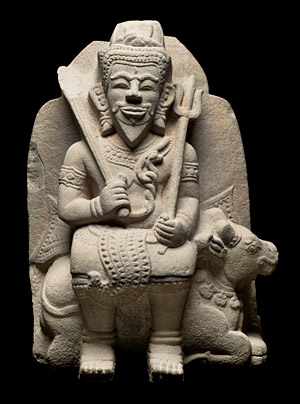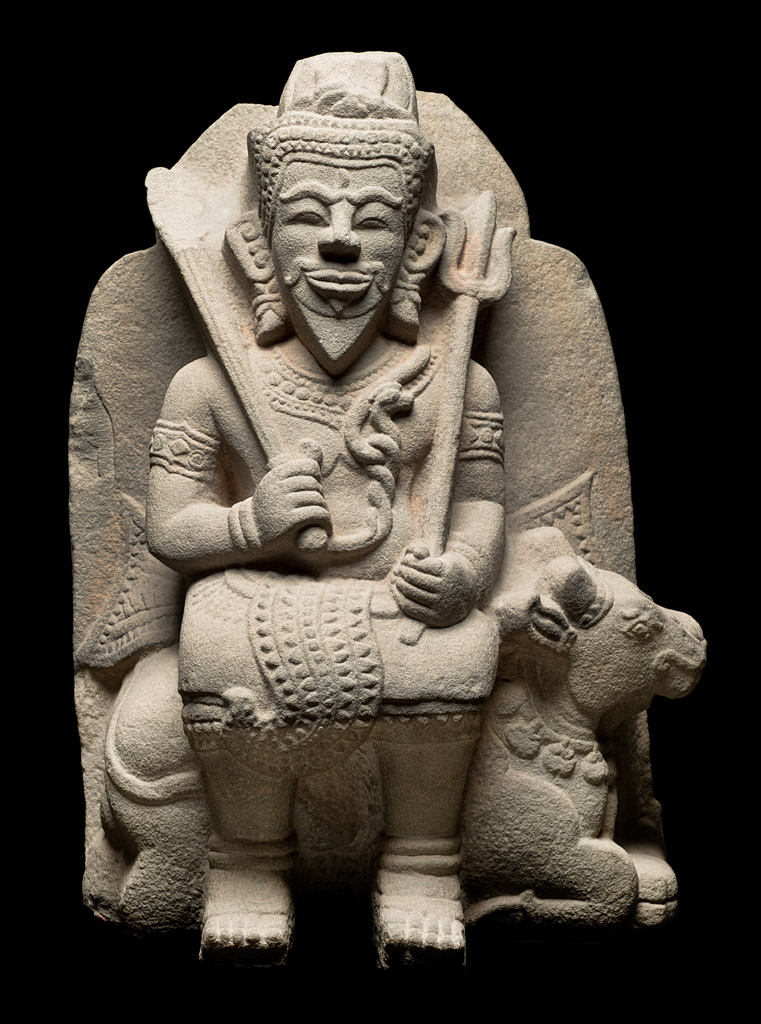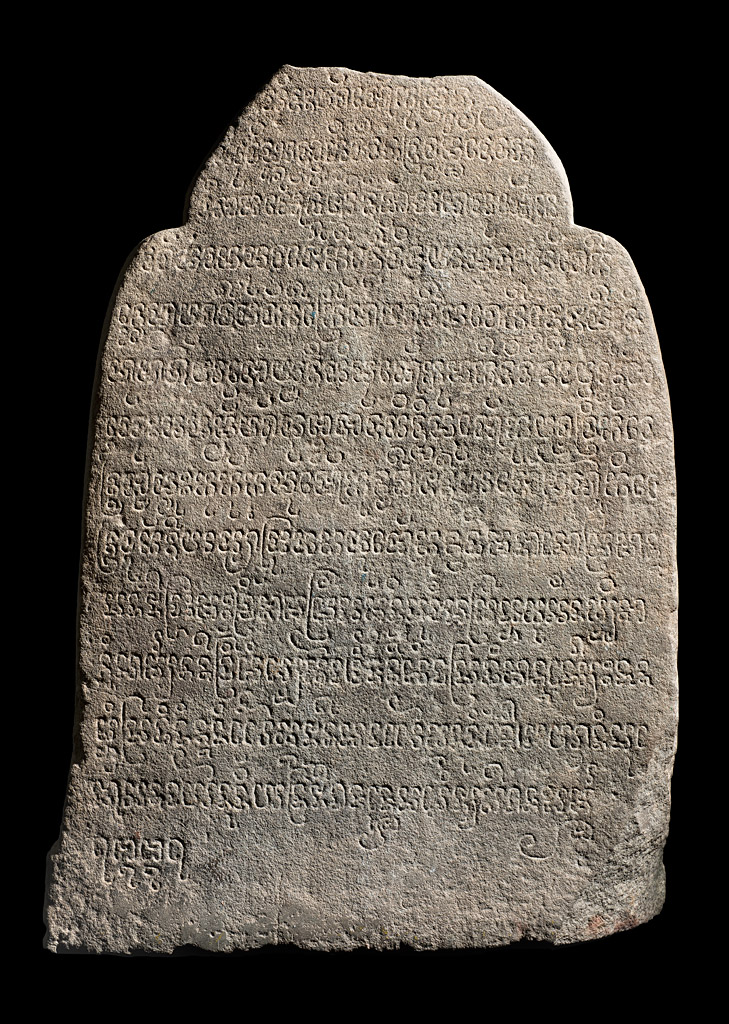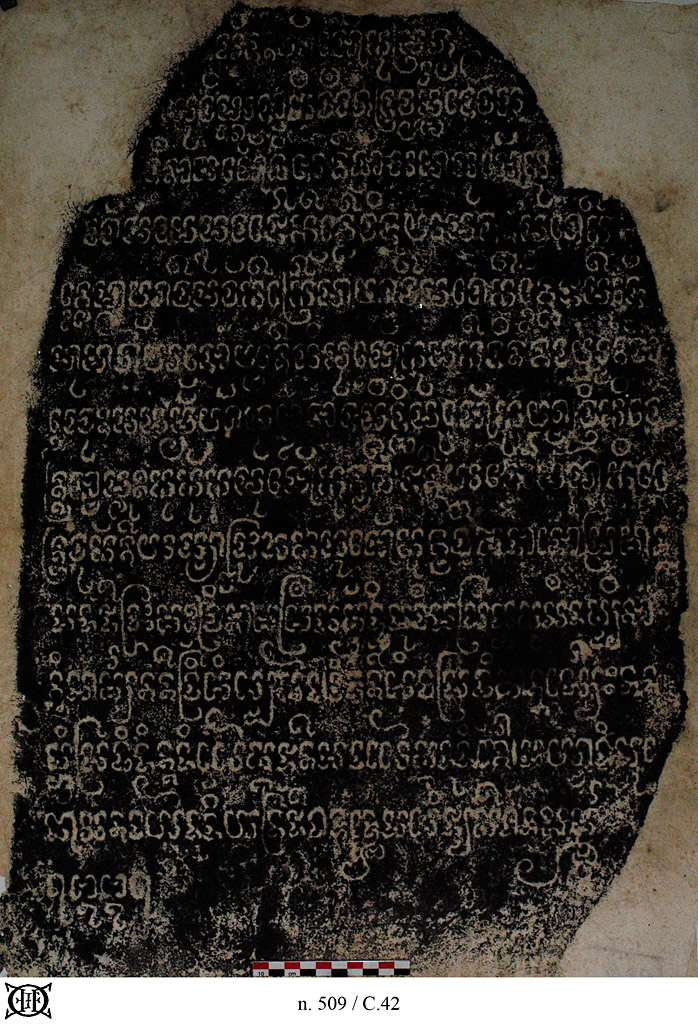Corpus of the Inscriptions of Campā






C. 42 Statue of Śiva mounted on his Bull from Drang Lai
Please note: you are reviewing a preprint version of this publication. Contents here may change significantly in future versions. Scholars with specific interests are urged to consult all cited bibliography before using our texts and translations or drawing other significant conclusions.
Support Back of a sculptural stela of Śiva seated on his Bull; sandstone; we have not had occasion to record dimensions, but Parmentier 1909: 563 recorded: h. 57 cm × w. 60.
Text Fourteen lines on one face written in Old Cam.
Date 1331 Śaka (1409/10 CE).
Origin Temple of Drang Lai (Gia Lai, Vietnam).
The first publications referring to this inscription mention it at a place called Cheo Reo, which then fell administratively in Phú Yên. Cheo Reo is the old name for the town (thị xã) of Ayun Pa, in the modern province of Gia Lai. While Finot referred to it as “inscription of Cheo Reo”, and was followed in this by several subsequent authors, the inscription has also been known as the Yang Mum stela, after the more famous shrine to which it was moved after it was discovered. But Prosper Odend’hal ascertained from local informants that the inscription had been moved to that shrine from another one, called Drang Lai. The inscription must properly be named after its original provenance. The inscription was first mentioned in a report, based on observations of “an annamite”, from missionary J.-B. Guerlach cited in BEFEO 1 (1901), p. 413. It was observed again by a certain Stenger (see BEFEO and 2 (1902), p. 227); presence at “Cheo Reo” described by Parmentier 1902: 282; proper provenance ascertained by Prosper Odend’hal in 1903 (see Finot 1904b: 535). The stela was described in Parmentier 1909: 562-563.1 It was received at the EFEO Museum in Tourane in 1927, as reported in BEFEO 27, p. 460.2 The stela was removed from the Museum under unknown circumstances at an unknown point of time, no doubt during the turbulent period between WW II and Vietnamese reunification in 1975. It resurfaced when it was acquired by the Museum of Fine Art in Boston (USA) in 1986, where it was recorded under acc. nr. 1986.331.
Edition(s) Mentioned by Majumdar 1927: 223, no. 118, whence by Golzio 2004: 199.3 About half of the text was edited, without translation, in Schweyer 2008a: 227. This first complete reading of the inscription was done from photographs provided by the Museum of Fine Art and the EFEO estampage.4
Facsimiles
- Estampage: EFEO 266
- Estampage: EFEO n. 509
The following text was edited by Arlo Griffiths and Amandine Lepoutre.
(2) ṣuviṣṇujāt(t)i vīrabhadravṛrmmadeva ā-
(3) dīnāma pom̃ cim̃ (ṇa)n· thām̃ amā pu pom̃ ku
(4) urām̃ paramapūra ṅauk· glaum̃ vijaya pajaḥ parok·
(5) glai hayāv· pavam̃k· kraum̃ hayāv· parok· glai ṅap· jem̃
(6) humā bhām̃ ya doṁ yvan· si pu pom̃ ku mak· di nagara yvan· vā
(7) rai vuḥ sa pamṛm̃m̃ yām̃ pu inā ja siddhi pu pom̃ ku yvā vrim̃ kire-
(8) ndra dvā pluḥ kukum̃ ka pu pom̃ ku gvac· | ṅan· ya doṁ mahnākire-
(9) ndra vukam̃n· ya syāṁ rūpa ka pu pom̃ ku gvac· madā do[ṁ] pramānna
(10) pada(m̃)ṅ· rūmaḥ vrim̃ nāma śrīsamṛm̃ddhipurī pakṛm̃tta kutī dakṣinā-
(11) gni harmya nan· vrim̃ śilpakāra | rijan· śivaprathimānna pyauḥ bha-
(12) nakti prathidinna di loka ṅan· paraloka dudim̃ nau | mayvā di pu p-
(13) om̃ tana rayā dudim̃ ya dṛm̃ṅ· rāja jmai paliṅyak· rājadharmma
(14) 1331
Translation
It is Y.P.K. Śrī Bṛṣuviṣṇujāti Vīrabhadravarmadeva. The original name of that (ṇan?) prince, like his father, P.P.K., is Man of Paramapūra Ṅauk Glauṅ Vijaya. He cleared and cut down the forest of Hayāv (‘Fish’?). He dammed the Hayāv river. He cut down the forest. He made the ricefields become dry (bhaṅ?). All the Viets whom P.P.K. captured in the land of the Viets, he brought [them] here and gave [them] as papamṛm̃ (cf. Old Khmer pamre?) to Milady the Mother who is successful. P.P.K. as guest (yvā?) gave twenty kirendra (‘montagnards’? correct mahnākirendra?) which/who(m) (kukum̃ = kum̃?) to P.P.K. gvac (ignore the punctuation |) together with all the other mahnākirendras who were beautiful in appearance to P.P.K. gvac present in all provinces. He erected a palace giving it the name Śrīsamṛddhipurī. He had made (pakṛm̃tta = pa-kṛta, causative prefix on Sanskrit form kṛta meaning ‘made’?) a chamber for the south fire of that stronghold. He instructed an artisan to make a statue (prathimānna = pratimā?) of Śiva. [He admonished the population:] Let there be worship every day, with a view to (the prosperity of all and sunder in) the world [here] and later in the next world! Go (ignore the punctuation |) as guests to their majesties in the future who will hold the kingdom (rāja = rājya)! Do not destroy the king’s foundation. [Engraved in the Śaka year] 1331.
Commentary
Secondary Bibliography
- Parmentier 1909: 562-563.
- BEFEO 28 (1928), p. 604.
- Dournes 1970: 146, 151.
- See photo 181 in Missions archéologiques françaises au Vietnam.
- ECIC III: 448.
Notes
- Two published photographs show the stela when it was placed at the temple of Yang Mum: fig. 129 on Parmentier 1909: 561 and photo 181 in Ghesquière et al. 2005.
- “Le Musée a reçu par les soins du Résident de Kontum les sculptures et inscriptions provenant de Draṅ-lai et de Yaṅ Mum qui avaient été groupées à la Résidence. C’est ainsi que la grande statue de Çiva qui trônait sur l’autel du temple de Yaṅ Mum (IC., I, p. 561), le Çiva sur Nandin, le petit Çiva assis devant un chevet inscrit au dos, et la stèle inscrite sur trois faces (ibid., p. 562, Liste Cœdès, C. 42-43), ces trois dernières pièces provenant de Draṅ-lai, ont trouvé au Musée un asile plus sûr que celui qu’il avait été possible de leur assurer jusqu’ici.”
- The information published by Golzio is at least eight decades outdated with regard to the location of the inscription, and even his source Majumdar was already wrong in stating that the inscription is “mutilated”. In fact the inscription is very well preserved.
- This estampage has been reproduced as fig. 8 (p. 43) in Schweyer 2005b.



The punctuation sign | apparently has to be ignored in order properly to break down the text. Comparison with the opening of inscriptions such as C. 30A1, C. 30B4, C. 47, C. 86.1, C. 89 (face B) and C. 225 strongly suggests that at least one, possibly two lines of text would, in the original state of the inscribed sculpture, have preceded the text as we have it now. Given the limited amount of space that would have been available between tapering margins, one expects little more that what we read e.g. in C. 86.1, lines 1-2: ((quatrefoil)) madā pu pom̃ tana rayā sidaḥ yām̃ pom̃ ku śrī jayaparameśvaravarmmadeva ..., or perhaps a shorter version of what we see in C. 225, l. 1-3: [|] ((quatrefoil)) | svasti | jaya ni trā madā paramarājādhirāja sidaḥ yām̃ pom̃ ku śrī vraṣuviṣṇujāt(t)i vīrabhadravarmmadeva ... . So the line-numbers adopted in this edition are off by 1 or 2 from the original state of the text.